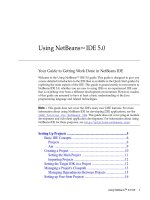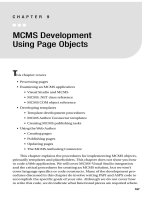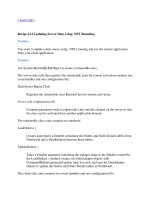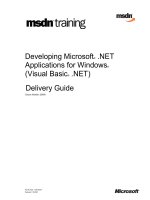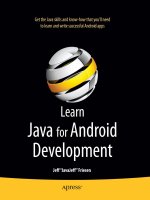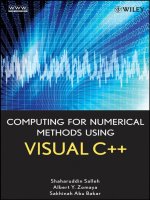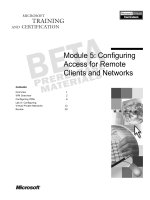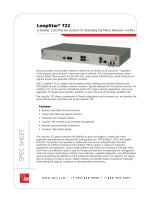beginning arcgis for desktop development using .net
Bạn đang xem bản rút gọn của tài liệu. Xem và tải ngay bản đầy đủ của tài liệu tại đây (28.35 MB, 532 trang )
www.it-ebooks.info
ffirs.indd iiffirs.indd ii 26/02/13 12:47 PM26/02/13 12:47 PM
www.it-ebooks.info
BEGINNING ARCGIS®
FOR DESKTOP DEVELOPMENT USING .NET
INTRODUCTION . . . . . . . . . . . . . . . . . . . . . . . . . . . . . . . . . . . . . . . . . . . . . . . . . . . . . . . . . . . . . xxi
PART I THE BASICS
CHAPTER 1 Why Geospatial Is Special . . . . . . . . . . . . . . . . . . . . . . . . . . . . . . . . . . . . . . . 3
CHAPTER 2 Introduction to ArcGIS for Desktop Applications Customization . . . . . 35
PART II .NET PROGRAMMING FUNDAMENTALS
CHAPTER 3 .NET Programming Fundamentals, Part I . . . . . . . . . . . . . . . . . . . . . . . . . . 63
CHAPTER 4 .NET Programming Fundamentals, Part II . . . . . . . . . . . . . . . . . . . . . . . . 103
PART III ARCOBJECTS PROGRAMMING
CHAPTER 5 Understanding ArcObjects Object Model Diagrams . . . . . . . . . . . . . . 139
CHAPTER 6 Accessing Maps and Layers . . . . . . . . . . . . . . . . . . . . . . . . . . . . . . . . . . . . 165
CHAPTER 7 Working with Tables and FeatureClasses . . . . . . . . . . . . . . . . . . . . . . . . 197
CHAPTER 8 Subsets of Records . . . . . . . . . . . . . . . . . . . . . . . . . . . . . . . . . . . . . . . . . . . 227
CHAPTER 9 Constructing and Using the Geometry of Features . . . . . . . . . . . . . . . . 257
CHAPTER 10 Rendering Geospatial Data and Using Hyperlinks and MapTips . . . . 295
CHAPTER 11 Labeling, Exporting ActiveView, and Working with Elements . . . . . . . 327
CHAPTER 12 Geoprocessing with Tools and Models . . . . . . . . . . . . . . . . . . . . . . . . . . 365
CHAPTER 13 Feature Data Management . . . . . . . . . . . . . . . . . . . . . . . . . . . . . . . . . . . . 403
CHAPTER 14 Advanced Topics in ArcObjects Programming and Deployment . . . . 429
APPENDIX Answers to Chapter Exercises . . . . . . . . . . . . . . . . . . . . . . . . . . . . . . . . . . 467
INDEX . . . . . . . . . . . . . . . . . . . . . . . . . . . . . . . . . . . . . . . . . . . . . . . . . . . . . . . . . . . . . . . . . . . . . 479
ffirs.indd iffirs.indd i 26/02/13 12:47 PM26/02/13 12:47 PM
www.it-ebooks.info
ffirs.indd iiffirs.indd ii 26/02/13 12:47 PM26/02/13 12:47 PM
www.it-ebooks.info
BEGINNING
ArcGIS
®
for Desktop Development
Using .NET
ffirs.indd iiiffirs.indd iii 26/02/13 12:47 PM26/02/13 12:47 PM
www.it-ebooks.info
ffirs.indd ivffirs.indd iv 26/02/13 12:47 PM26/02/13 12:47 PM
www.it-ebooks.info
BEGINNING
ArcGIS
®
for Desktop Development
Using .NET
Pouria Amirian
ffirs.indd vffirs.indd v 26/02/13 12:47 PM26/02/13 12:47 PM
www.it-ebooks.info
This edition rst published 2013
© 2013 John Wiley & Sons, Ltd.
Registered of ce
John Wiley & Sons Ltd, The Atrium, Southern Gate, Chichester, West Sussex, PO19 8SQ, United Kingdom
For details of our global editorial of ces, for customer services and for information about how to apply for permission to
reuse the copyright material in this book please see our website at www.wiley.com.
The right of the author to be identi ed as the author of this work has been asserted in accordance with the Copyright,
Designs and Patents Act 1988.
All rights reserved. No part of this publication may be reproduced, stored in a retrieval system, or transmitted, in any
form or by any means, electronic, mechanical, photocopying, recording or otherwise, except as permitted by the UK
Copyright, Designs and Patents Act 1988, without the prior permission of the publisher.
Wiley also publishes its books in a variety of electronic formats. Some content that appears in print may not be available
in electronic books.
Designations used by companies to distinguish their products are often claimed as trademarks. All brand names and
product names used in this book are trade names, service marks, trademarks or registered trademarks of their respective
owners. The publisher is not associated with any product or vendor mentioned in this book. This publication is designed
to provide accurate and authoritative information in regard to the subject matter covered. It is sold on the understanding
that the publisher is not engaged in rendering professional services. If professional advice or other expert assistance is
required, the services of a competent professional should be sought.
Limit of Liability/Disclaimer of Warranty: The publisher and the author make no representations or warranties with
respect to the accuracy or completeness of the contents of this work and speci cally disclaim all warranties, including
without limitation warranties of tness for a particular purpose. No warranty may be created or extended by sales or
promotional materials. The advice and strategies contained herein may not be suitable for every situation. This work is
sold with the understanding that the publisher is not engaged in rendering legal, accounting, or other professional
services. If professional assistance is required, the services of a competent professional person should be sought. Neither
the publisher nor the author shall be liable for damages arising herefrom. The fact that an organization or Web site is
referred to in this work as a citation and/or a potential source of further information does not mean that the author or the
publisher endorses the information the organization or Web site may provide or recommendations it may make. Further,
readers should be aware that Internet Web sites listed in this work may have changed or disappeared between when this
work was written and when it is read.
Trademarks: Wiley, Wrox, the Wrox logo, Wrox Programmer to Programmer, and related trade dress are trademarks or
registered trademarks of John Wiley & Sons, Inc. and/or its af liates, in the United States and other countries, and may
not be used without written permission. ArcGIS is a registered trademark of Esri in the United States and other countries.
All other trademarks are the property of their respective owners. John Wiley & Sons, Ltd. is not associated with any
product or vendor mentioned in this book.
A catalogue record for this book is available from the British Library.
978-1-118-44254-8 (paperback)
978-1-118-44253-1 (ebook)
978-1-118-44255-5 (ebook)
978-1-118-44252-4 (ebook)
Set in 9.5 /12 Sabon LT Std Roman, by MPS Limited, Chennai, India.
Printed in the United States by Bind-Rite
ffirs.indd viffirs.indd vi 26/02/13 12:47 PM26/02/13 12:47 PM
www.it-ebooks.info
To the best mother and father in the whole world, Nosratolah and Soghra
To the best wife in the solar system, Ana
To the best sister and brother in the Milky Way, Paria and Payam
ffirs.indd viiffirs.indd vii 26/02/13 12:47 PM26/02/13 12:47 PM
www.it-ebooks.info
ffirs.indd viiiffirs.indd viii 26/02/13 12:47 PM26/02/13 12:47 PM
www.it-ebooks.info
ABOUT THE AUTHOR
POURIA AMIRIAN holds a Ph.D. in Geospatial Information Systems (GIS).
Dr. Amirian is a developer and GIS/IT lecturer with extensive experience developing
and deploying small to large-scale Geospatial Information Systems. At the moment
he is a research fellow of Strategic Research in Advanced Geotechnologies
(
www.StratAG.com) at the National University of Ireland in Maynooth, where he
focuses on Geospatial Service Oriented Architecture and working with NoSQL
databases to handle big geospatial data. When he is not coding, Pouria is often found
reading aviation magazines or practicing Wing Tsun. Pouria welcomes feedback about
this book by email at
ffirs.indd ixffirs.indd ix 26/02/13 12:47 PM26/02/13 12:47 PM
www.it-ebooks.info
ffirs.indd xffirs.indd x 26/02/13 12:47 PM26/02/13 12:47 PM
www.it-ebooks.info
Michelle Leete
—
Martin Tribe
Chris Webb
Ellie Scott
Louise Breinholt
Lorna Mein
Kate Parrett
Jodi Jensen
Sara Shlaer
Tom Dinse
Alexey Tereshenkov
Daniel Scribner
Louise Watson, Word One
John Sleeva
LeAndra Young
©Anahid Basiri
CREDITS
ffirs.indd xiffirs.indd xi 26/02/13 12:47 PM26/02/13 12:47 PM
www.it-ebooks.info
ffirs.indd xiiffirs.indd xii 26/02/13 12:47 PM26/02/13 12:47 PM
www.it-ebooks.info
ACKNOWLEDGMENTS
EVEN THOUGH THE AUTHOR’S NAME is the one that graces the cover of a book, no book is the result
of one person’s efforts, and I’d like to thank a few of the people involved in this one. First and fore-
most, thanks to John Wiley & Sons for giving me the opportunity to write and providing me such
a brilliant team for publishing this book. They were the only people willing to take a risk on an
unknown author for the rst book on GIS published by Wrox, and for that I will be forever grateful.
Thanks to the staff of John Wiley & Sons — speci cally Tom Dinse, Debbye Butler, Daniel Scribner
and Louise Watson, whose watchful eyes saved me from potentially embarrassing mistakes. Thanks
also to Chris Webb for getting me started with the book and Ellie Scott for keeping me on track. All
of them did a great job of dealing with the frequent changes I made to the book as I was writing.
I’d like to thank my technical editor, Alexy Treshenkov, whose efforts made this book far better
than it would have been otherwise.
I’d also like to thank Dr. Adam Winstanley, head of the Department of Computer Science at the
National University of Ireland, Maynooth (NUIM), Dr. Martin Charlton from the National Centre
for Geocomputation (NCG) Ireland, and Dr. Jan Rigby, program manager of StratAG (Strategic
Research in Advanced Geotechnologies).
My gratitude, also, to those who helped create the .NET Framework, ArcObjects, tools, APIs,
libraries, standards, speci cations and all the other fun stuff that helps bring the geospatial to the
mainstream and make GIS development and programming exciting today.
I would like to thank everyone who bought this book! I sincerely hope you have as much fun read-
ing it as I did writing it, and I hope that you nd it to be worth your hard-earned money and that it
proves to be an educational and eye-opening experience.
It is time for expressing my feelings that never can be told using words. I am the luckiest person in
the whole world because I have the greatest parents. I want to thank them for countless reasons: for
always listening patiently, for their constant support, and for always being by my side. Also, I am so
grateful to my father- and mother-in-law for all they do for Ana and me. I owe my life to my wife;
my unprecedented wife Dr. Anahid Basiri, who saved my life with her love, passion, and patience. In
addition to being the rst reader of the book, Ana also took the photograph that is on the cover of
this book. This is an image of the International Neuroscience Institute (INI).
Last but most de nitely not least, we both (Ana and I) appreciate the high level of care and support
of all INI’s staff, especially Prof. M. Samii, Dr. J. Pieper, Prof. B. Mohammadi, and Prof. A. Samii.
The service I got there was more like inspiration rather than just a brain surgery. In fact, the idea of
writing this book had been on my mind for several years, but when I was in INI, I promised myself
I would write this book, and now I am so happy to make this promise come true. To be honest,
I want to thank that brain tumor because after getting rid of it, I started truly living every single
moment. My life is now so joyful that if I could go back and choose not to have such a problem, to
continue my life as it was, I would de nitely choose to have that brain tumor and successful surgery
and to enjoy every single moment beside my family as I am doing now.
ffirs.indd xiiiffirs.indd xiii 26/02/13 12:47 PM26/02/13 12:47 PM
www.it-ebooks.info
ffirs.indd xivffirs.indd xiv 26/02/13 12:47 PM26/02/13 12:47 PM
www.it-ebooks.info
CONTENTS
INTRODUCTION xxi
PART I: THE BASICS
CHAPTER 1: WHY GEOSPATIAL IS SPECIAL 3
A Tour of Geospatial Data 4
Why Geospatial Is Special 8
Various Kinds of GIS Software 10
Server GIS 11
Desktop GIS 13
Developer GIS 17
Mobile GIS 18
Geospatial Data Models and Storage 19
Raster 19
Vector 20
Geospatial Data as Text or Binary File 20
Geospatial Data in Georelational Models 21
Geospatial Data Inside Spatial DBMS 21
Geospatial Data in XML Structures 23
Esri Geodatabase 30
Personal Geodatabase 30
File Geodatabase 30
ArcSDE Geodatabase 31
Summary 32
CHAPTER 2: INTRODUCTION TO ARCGIS FOR
DESKTOP APPLICATIONS CUSTOMIZATION 35
Four Ways to Customize ArcGIS for Desktop 36
Customizing the User Interface 37
Scripting 41
Desktop Add-Ins 48
ArcObjects SDK 55
Summary 59
ftoc.indd xvftoc.indd xv 25/02/13 4:06 PM25/02/13 4:06 PM
www.it-ebooks.info
xvi
CONTENTS
PART II: .NET PROGRAMMING FUNDAMENTALS
CHAPTER 3: .NET PROGRAMMING FUNDAMENTALS, PART I 63
The .NET Framework 63
The C# Language 64
A Brief History of C# 64
Basic Concepts 65
Variables and Data Types 66
Nullable Data Types 71
Operations on Variables 71
Arrays 75
Decision-Making 76
Iteration 78
Object Manipulation 81
Data Type Conversion 83
Enumerations 85
Methods 89
Introduction to Object-Oriented Programming in C# 93
Object-Oriented Programming in Action 94
Defi ning Properties 96
Defi ning Methods 98
Defi ning Constructors 98
Summary 100
CHAPTER 4: .NET PROGRAMMING FUNDAMENTALS, PART II 103
Overview of Object-Oriented Programming Concepts 104
Abstraction 104
Encapsulation 104
Inheritance 105
Polymorphism 106
Reference Types and Value Types 108
Assignment Operations 108
Comparison Operations 109
Passing Parameters between Method Calls 109
Brief Explanation of All .NET Types 111
Namespaces and Assemblies 112
Debugging Using Visual Studio 113
Structured Exception Handling 117
Casting Objects 120
Aggregation Using Collections 121
ftoc.indd xviftoc.indd xvi 25/02/13 4:06 PM25/02/13 4:06 PM
www.it-ebooks.info
xvii
CONTENTS
The ArrayList 122
Generics 123
Reading and Writing Files 123
Summary 135
PART III: ARCOBJECTS PROGRAMMING
CHAPTER 5: UNDERSTANDING ARCOBJECTS OBJECT MODEL
DIAGRAMS 139
What Is ArcObjects? 140
Interface-Based Programming in Brief 140
Understanding Object Model Diagrams 144
Types of Classes in ArcObjects 145
Relationships between Classes 147
Members of Interfaces 149
Interface Inheritance 151
Wormhole 153
Additional Tips for Using Object Model Diagrams 153
Where to Start with ArcObjects 155
How to Find an Associated Member 156
Summary 163
CHAPTER 6: ACCESSING MAPS AND LAYERS 165
Introduction to Maps and Layers In ArcObjects 165
General Properties of All Layers 175
Working with FeatureLayers 179
Working with RasterLayers 183
Adding an Existing *.lyr File to a Map 184
Adding *.lyr Files Using GxDialog 186
Saving *.lyr and *.mxd Files 191
Summary 194
CHAPTER 7: WORKING WITH TABLES AND FEATURECLASSES 197
Accessing Tables and FeatureClasses 197
Adding and Deleting Fields 204
Adding Existing FeatureClasses, Tables, and Rasters to a Map 207
Deleting an Existing FeatureDataset, FeatureClass,
Table, or Raster 215
Creating Tables and Rows 215
Summary 225
ftoc.indd xviiftoc.indd xvii 25/02/13 4:06 PM25/02/13 4:06 PM
www.it-ebooks.info
xviii
CONTENTS
CHAPTER 8: SUBSETS OF RECORDS 227
Using Object Model Diagrams for Selecting Features and Rows 228
Working with Existing Selections 229
Selecting Rows and Features 233
Accessing a Subset of Records 237
Simple Statistics of Features 245
Some Important Points about Using Cursors 251
Displaying Subsets of Geospatial Data 254
Summary 255
CHAPTER 9: CONSTRUCTING AND USING THE
GEOMETRY OF FEATURES 257
Object Model Diagram for the Geometry
of Features and Graphics 258
Displaying Geometries on the Screen 260
Creating and Drawing Points 261
Creating and Drawing Multipoints 264
Creating and Drawing Polylines 268
Creating and Drawing Polygons 272
Creating a New Feature and Editing
an Existing Feature’s Geometry 276
Working with Spatial Operators 281
Examining Spatial Relationships 281
Common Geoprocessing Operations 284
Determining the Nearest Points and Distance 287
Length, Area, Centroid, and Envelope of Geometries 292
Summary 293
CHAPTER 10: RENDERING GEOSPATIAL DATA AND
USING HYPERLINKS AND MAPTIPS 295
Geospatial Data Display 296
Color and ColorRamp Classes 296
Symbols 298
Renderers for Vector and Raster Geospatial Data 300
Going beyond Simple Display 318
Simple and Advanced MapTips 319
Hyperlinks 321
Summary 324
ftoc.indd xviiiftoc.indd xviii 25/02/13 4:06 PM25/02/13 4:06 PM
www.it-ebooks.info
xix
CONTENTS
CHAPTER 11: LABELING, EXPORTING ACTIVEVIEW,
AND WORKING WITH ELEMENTS 327
Labeling 328
Labeling with the Default Labeling Engine 329
Labeling with the Maplex Labeling Engine 334
Exporting the ActiveView 336
Working with Elements 346
Adding GraphicElements 348
Adding FrameElements 352
Summary 361
CHAPTER 12: GEOPROCESSING WITH TOOLS AND MODELS 365
ArcObjects and the Geoprocessing Framework 365
Running Geoprocessing Tools 366
Running Custom Tools 375
Opening a Tool’s Dialog Box in Code 384
Geoprocessing in the Background 389
Bach Processing 397
Can I Manage the Execution of Geoprocessing Tools? 399
Summary 400
CHAPTER 13: FEATURE DATA MANAGEMENT 403
Use of GUID in ArcObjects 404
Working with the Geodatabase Model 406
Creating Geodatabases 407
Creating FeatureDatasets and FeatureClasses 408
Working with Features 418
Creating New Features 418
Modifying Existing Features 422
Summary 426
CHAPTER 14: ADVANCED TOPICS IN ARCOBJECTS
PROGRAMMING AND DEPLOYMENT 429
Sharing State and Functionality between Components 430
Event Handling in ArcObjects 432
Application Extension 435
Add-In Deployment 450
Preparing for Release 450
ftoc.indd xixftoc.indd xix 25/02/13 4:06 PM25/02/13 4:06 PM
www.it-ebooks.info
xx
CONTENTS
Add-In File Structure 452
Distributing and Installing an Add-In 453
Custom Component Deployment 456
Creating an Installer for Custom Component 459
Summary 465
APPENDIX: ANSWERS TO CHAPTER EXERCISES 467
INDEX 479
ftoc.indd xxftoc.indd xx 25/02/13 4:06 PM25/02/13 4:06 PM
www.it-ebooks.info
INTRODUCTION
WELCOME TO Beginning ArcGIS for Desktop Development Using .NET. If you have always wanted
to start your journey in the world of ArcObjects, this book is your perfect one-stop resource.
Whether you are a new ArcGIS user with no background in programming or a programmer with
a little experience in the ArcGIS platform, this book helps you be more productive. This book
starts with the basics and brings you thoroughly up to speed. You rst discover all you need to
know about .NET programming for developing ArcObjects: variables, ow control, object-oriented
programming, and interface-based programming. Then the book helps you build skills
for developing ArcObjects and creating Desktop Add-Ins; reading object model diagrams; querying
data; working with symbology, the geometry of geospatial data, and geoprocessing; and nally,
deploying code.
WHO THIS BOOK IS FOR
This book is for anyone who wants to learn how to customize and extend Esri’s ArcGIS for Desktop
applications using .NET. It is intended for anyone who wants to learn ArcObjects step by step. With
the knowledge gained after reading this book, you will be able to build different kinds of add-ins
and traditional ArcObjects developments in Visual Studio.
No prior background in programming is assumed, and anyone familiar with ArcGIS should be able
to follow the examples. It does help, however, if you have a basic understanding of .NET and COM.
The book starts with programming in .NET and ends by covering deployment topics. Each chapter
is built on the knowledge gained in previous chapters.
This book is also for anyone who knows how to customize and develop ArcGIS using Visual Basic
for Application (VBA) or Visual Basic 6. If this is your interest, you’ve gained a lot from the new
capabilities of the 10.X versions of ArcGIS.
All example code in this book is presented in C#, which can be easily converted to Visual Basic.NET.
If you are a hard-core fan of VB.NET don’t worry. All the source code used in this book is available
for download in both C# and VB.NET at
www.wrox.com (for more information, see the “Source
Code” section later in this introduction).
WHAT THIS BOOK COVERS
This book walks you through ArcGIS development from the very rst steps to the deployment
phase. You will learn that it is a simple task to customize and develop ArcGIS for Desktop
applications — this process isn’t as hard as it seems at rst. In other words, developing
ArcObjects is not rocket science.
flast.indd xxiflast.indd xxi 25/02/13 12:33 PM25/02/13 12:33 PM
www.it-ebooks.info
xxii
INTRODUCTION
This book uses the latest version of ArcGIS, which is ArcGIS 10.1. All the code examples are
tested to work in version 10.0 as well. The focus of this book is on creating a new model of ArcGIS
customization: the Desktop Add-In (or add-in for short). Unfortunately, the add-in model is not
available for previous versions of ArcGIS (8.x and 9.x). However, if you have one of the older
versions, you can still use this book to create traditional ArcObjects projects (Extending ArcObjects
Template in Visual Studio).
HOW THIS BOOK IS STRUCTURED
This book is divided into three parts. The following explains each of these three parts in detail, and
what each chapter covers.
Part I: The Basics
Throughout Chapters 1 and 2, you will see different approaches for customizing ArcGIS for
Desktop applications.
➤
Chapter 1, “Why Geospatial Is Special”: This chapter shows you some unique
characteristics of geospatial data. Then it explains the different kinds of GIS software and
provides a high-level survey of the ArcGIS platform. The chapter nishes with an overview
of the major approaches for storing and managing geospatial data.
➤
Chapter 2, “Introduction to ArcGIS for Desktop Applications Customization”: Chapter 2
looks at different approaches for customizing ArcGIS for Desktop applications. It introduces
techniques for customizing the user interface, Python scripting, Desktop Add-Ins, and
extending ArcObjects. For each approach, I present at least one Try It Out example to show
you how the different approaches t together.
Part II: .NET Programming Fundamentals
In Chapters 3 and 4, you gain the necessary knowledge of .NET programming to put
ArcObjects to work.
➤
Chapter 3, “.NET Programming Fundamentals, Part I”: Chapter 3 explains the basic
elements of C# that are necessary for successful ArcObjects development. The chapter
covers topics such as variables, arrays, operators, decision making, iteration, object
manipulation, enumeration, and the basics of object-oriented programming. When you
complete this chapter, you will have good knowledge of implementing properties, methods,
and constructors for classes.
➤
Chapter 4, “NET Programming Fundamentals, Part II”: This chapter is the second and
nal chapter on pure .NET programming. You complete the big picture of object-oriented
programming in C# by exploring object-oriented principles and techniques. I explain the
concept of types in .NET and how reference types differ from value types. The nal topics
in this chapter include accessing les and folders and creating a simple KMZ (Keyhole
Markup Language Zipped) le.
flast.indd xxiiflast.indd xxii 25/02/13 12:33 PM25/02/13 12:33 PM
www.it-ebooks.info
xxiii
INTRODUCTION
Part III: ArcObjects Programming
Throughout the chapters in this part, you learn ArcObjects programming from the ground up.
➤
Chapter 5, “Understanding ArcObjects Object Model Diagrams”: Part III starts with one
of the rst things you have to know in the ArcObjects world — object model diagrams.
Chapter 5 shows you how to read and interpret the different symbols of object model
diagrams that are part of ArcObjects developer help. In addition, this chapter describes the
technique of interface-based programming.
➤
Chapter 6, “Accessing Maps and Layers”: You put your knowledge of reading object model
diagrams to work and use various classes in ArcObjects to access various properties of maps
and layers. You also create your rst add-in button to get basic information about existing
Data Frames and layers in the main window of ArcMap.
➤
Chapter 7, “Working with Tables and FeatureClasses”: Tables and FeatureClasses are the
most common structures for storing geospatial data in the ArcGIS platform. You learn how
to access existing tables and FeatureClasses inside a map and how to add and delete a eld
in a table. Finally, this chapter looks at the topic of creating tables and records.
➤
Chapter 8, “Subsets of Records”: Querying geospatial data and working with selections
are explored in this chapter. It also explores cursors and calculating simple statistics out of
numeric elds.
➤
Chapter 9, “Constructing and Using the Geometry of Features”: This chapter explains how
to create different types of geometries for different types of features. As a related topic, this
chapter explores the most common types of geoprocessing analysis, such as buffer, overlay,
and union using the ArcObjects Geometry library.
➤
Chapter 10, “Rendering Geospatial Data and Using Hyperlinks and MapTips”: This
chapter presents an overview of setting symbology for vector and raster layers and explores
some types needed when working with Renderer classes. The contents of this chapter can be
divided into two parts: The rst part discusses how to change the appearance of geospatial
data, and the second part deals with how to make features to go beyond display through
hotlinks, hyperlinks, and MapTips.
➤
Chapter 11, “Labeling, Exporting ActiveView, and Working with Elements”: This
chapter covers some topics related to creating softcopy output out of geospatial data.
This chapter presents an overview of making different kinds of labels using the standard
and Maplex labeling engines. Exporting an ActiveView is also covered in detail, and
nally you learn about working with elements and getting prebuilt items from the Style
Manager.
flast.indd xxiiiflast.indd xxiii 25/02/13 12:33 PM25/02/13 12:33 PM
www.it-ebooks.info
